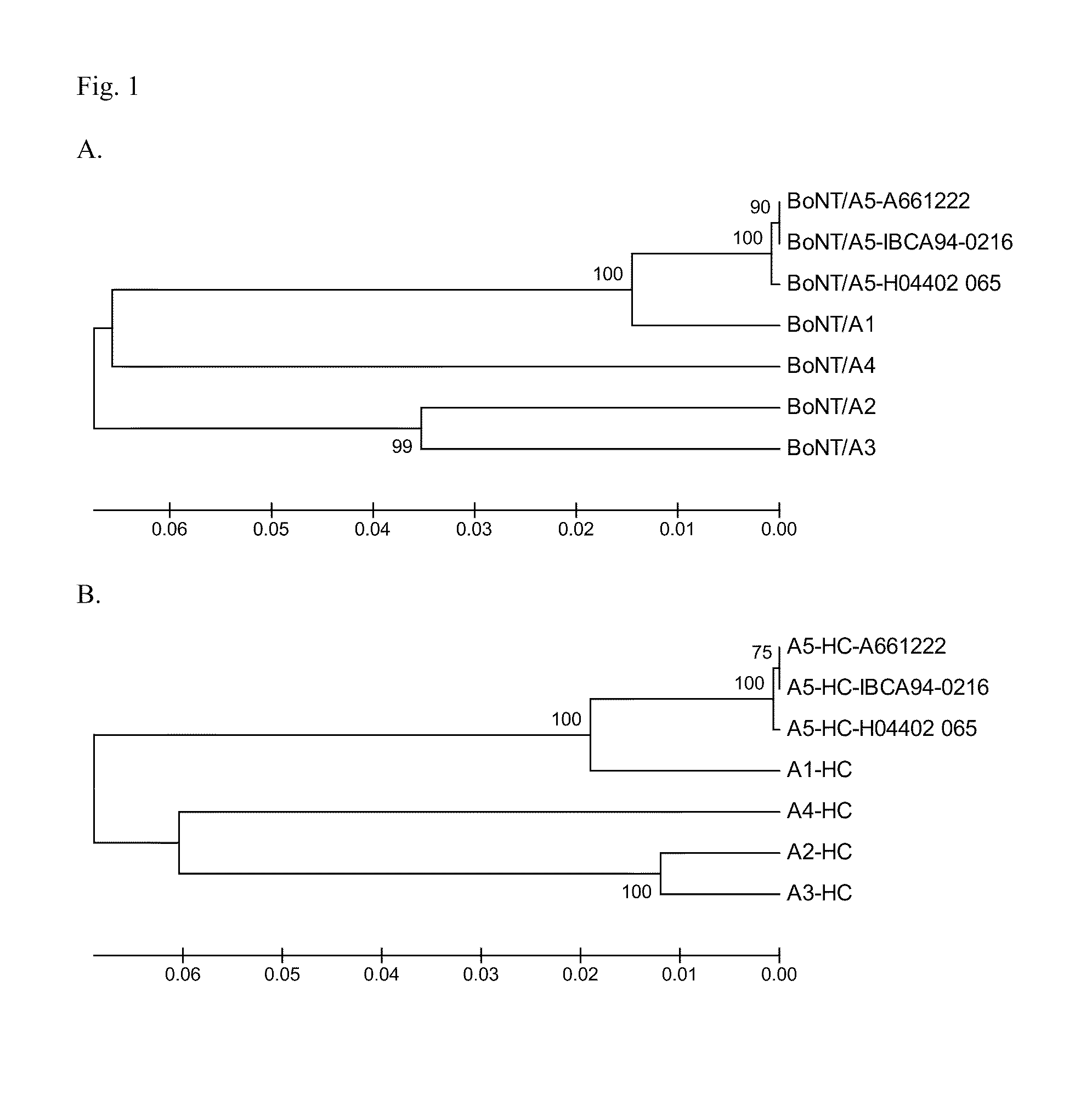Novel Subtype of Closteridium Botulinum Neurotoxin Type A and Uses Thereof
a neurotoxin and neurotoxin technology, applied in the field of new neurotoxin subtypes of closteridium botulinum, can solve the problems of patients becoming unresponsive to subsequent repeated treatments, eliminating the effectiveness of toxin for medicinal and cosmetic purposes, etc., and achieve the effect of improving the medicinal use of bonts
- Summary
- Abstract
- Description
- Claims
- Application Information
AI Technical Summary
Benefits of technology
Problems solved by technology
Method used
Image
Examples
example 1
Results
[0061]Identification and Sequencing of the Neurotoxin Gene and its Associated Cluster Genes
[0062]PCR and sequencing reactions were performed on the neurotoxin and the associated neurotoxin cluster genes of C. botulinum A661222, and the results were compiled using the VectorNTI Suite Program. These studies involved a process of amplifying overlapping pieces of the neurotoxin and its associated cluster. Based on this work, it was determined that the A661222 strain contained only one neurotoxin gene cluster consisting of a complete HA cluster with ha70, ha17, ha33, botR, ntnh and bont / a. This arrangement is consistent with the cluster arrangement identified in other BoNT / A5 producing strains (Carter, A. T., et al., 2009, BMC Genomics 10:115; Dover, N., et al., 2009, J. Clin. Microbiol. 47:2349-2350).
[0063]Comparison of the Neurotoxin and Associated HA Cluster Proteins Between Strain A661222 and Two Other A5 Strains IBCA94-0216 and H04402 065
[0064]When the neurotoxin gene cluster...
example 2
Materials and Methods
[0094]Bacterial strains and growth conditions. Clostridium botulinum strains A661222 and ATCC 3502 included in this study were from the Eric A. Johnson (EAJ) strain collection. The A661222 strain was grown from a lyophilized culture which was received from the Lanzhou Institute in February 1981. Cultures were grown in 10 mL of sterile TPGY media (per liter: 50 g trypticase peptone, 5 g Bacto peptone, 4 g A-glucose, 20 g yeast extract, 1 g cysteine-HC1, at pH 7.4) for 2 days at 37° C. under anaerobic conditions.
[0095]Total genomic DNA isolation. Total genomic DNA was isolated from C. botulinum by lysozyme and proteinase K treatment as described previously (Dineen, S. S., et al., 2003, Curr. Microbiol. 46:345-352). DNA was then diluted to a concentration of 50 ng / μL and used for PCR amplification.
[0096]PCR amplification and DNA sequencing. PCR amplifications were performed using the GeneAmp® High Fidelity PCR System (Applied BioSystems). PCR cycles were as follows...
PUM
| Property | Measurement | Unit |
|---|---|---|
| Fraction | aaaaa | aaaaa |
| Fraction | aaaaa | aaaaa |
| Atomic weight | aaaaa | aaaaa |
Abstract
Description
Claims
Application Information
 Login to View More
Login to View More - R&D
- Intellectual Property
- Life Sciences
- Materials
- Tech Scout
- Unparalleled Data Quality
- Higher Quality Content
- 60% Fewer Hallucinations
Browse by: Latest US Patents, China's latest patents, Technical Efficacy Thesaurus, Application Domain, Technology Topic, Popular Technical Reports.
© 2025 PatSnap. All rights reserved.Legal|Privacy policy|Modern Slavery Act Transparency Statement|Sitemap|About US| Contact US: help@patsnap.com



